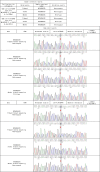A case report and literature review of self-improving collodion baby in the newborn
- PMID: 40193669
- PMCID: PMC11977717
- DOI: 10.1097/MD.0000000000042045
A case report and literature review of self-improving collodion baby in the newborn
Abstract
Rationale: Self-improving collodion baby (SICB) is a rare subtype of autosomal recessive congenital ichthyosis with distinct clinical features and generally favorable prognosis. This study aims to enhance understanding of SICB by examining its clinical characteristics and recent developments in diagnosis and management. Our findings provide insights that may aid in the etiological diagnosis and treatment of congenital ichthyosis.
Patient concerns: We present a case of SICB treated at Peking University Shenzhen Hospital, characterized by the appearance of a collodion membrane at birth. The primary approach involved intensive moisturizing care to manage skin abnormalities.
Diagnoses: Based on clinical examination and genetic testing, a diagnosis of SICB was confirmed, with mutations identified in genes commonly associated with autosomal recessive congenital ichthyosis, such as ALOX12B, TGM1, ALOXE3, CYP4F22, and PNPLA1.
Outcomes: The patient showed significant improvement following targeted supportive care, consistent with the generally positive prognosis for SICB.
Lessons: A comprehensive literature review of 31 SICB cases from 18 studies highlighted that the condition typically presents at birth with a collodion membrane. Intensive moisturizing is the main treatment, and early genetic testing is recommended to facilitate timely diagnosis and intervention. Early diagnosis can support effective genetic counseling and improve outcomes for newborns with ichthyosis.
Keywords: autosomal recessive congenital ichthyosis; collodion baby; newborn; self-improving collodion ichthyosis; whole exome sequencing.
Copyright © 2025 the Author(s). Published by Wolters Kluwer Health, Inc.
Conflict of interest statement
The authors have no funding and conflicts of interest to disclose.
Figures
Similar articles
-
A case of self-improving collodion ichthyosis in Vietnam.Pediatr Dermatol. 2020 May;37(3):574-575. doi: 10.1111/pde.14128. Epub 2020 Feb 27. Pediatr Dermatol. 2020. PMID: 32105361
-
Genotype-phenotype correlation in a large English cohort of patients with autosomal recessive ichthyosis.Br J Dermatol. 2020 Mar;182(3):729-737. doi: 10.1111/bjd.18211. Epub 2019 Aug 26. Br J Dermatol. 2020. PMID: 31168818
-
Case report of self-improving collodion ichthyosis in the newborn.J Int Med Res. 2023 Oct;51(10):3000605231204491. doi: 10.1177/03000605231204491. J Int Med Res. 2023. PMID: 37848341 Free PMC article.
-
Autosomal recessive congenital ichthyosis.Actas Dermosifiliogr. 2013 May;104(4):270-84. doi: 10.1016/j.adengl.2011.11.021. Epub 2013 Apr 3. Actas Dermosifiliogr. 2013. PMID: 23562412 Review. English, Spanish.
-
Update on autosomal recessive congenital ichthyosis: mRNA analysis using hair samples is a powerful tool for genetic diagnosis.J Dermatol Sci. 2015 Jul;79(1):4-9. doi: 10.1016/j.jdermsci.2015.04.009. Epub 2015 Apr 30. J Dermatol Sci. 2015. PMID: 25982146 Review.
References
-
- Hake L, Süssmuth K, Komlosi K, et al. . Quality of life and clinical characteristics of self-improving congenital ichthyosis within the disease spectrum of autosomal-recessive congenital ichthyosis. J Eur Acad Dermatol Venereol. 2022;36:582–91. - PubMed
-
- Galeazzo B, Valerio E, Cutrone M. Acral self-healing collodion baby. Arch Dis Child Fetal Neonatal Ed. 2017;102:F542–3. - PubMed
-
- Cuperus E, Bolling MC, de Graaf M, et al. . Collodion babies: A 15-year retrospective multicenter study in The Netherlands – Evaluation of severity scores to predict the underlying disease. J Am Acad Dermatol. 2021;84:1111–3. - PubMed
-
- de Jonge CJE, van der Smagt JJ, van Gijn ME, De Graaf M. Self-healing collodion baby: a new mutation. Nederlands Tijdschrift voor Dermatologie en Venereologie. 2019;29:72–4.
Publication types
MeSH terms
LinkOut - more resources
Full Text Sources




